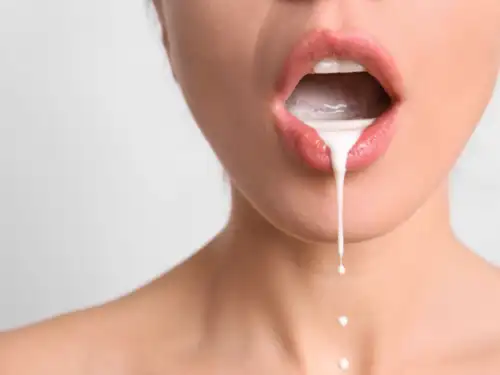Tasting someone is comparatively rare and intimate, which often means it’s less forgettable. Though, that’s not the only reason you’re likely to remember tasting your lover. Taste-related sensory experiences are memorable because emotion plays a huge role in the ability to make and recall memories—and it just so happens that taste is linked with emotion. Taste has also been closely tied to the ability to learn, and what better way to learn than with a study buddy?
Sharing a gustatory adventure with another person is such a special and unique sensory experience. It can be a sexy harbinger of things to come. That’s why romantic dinners are shared, why coffee dates are a mating season staple, and why oral sex can be so rewarding. Tasting another intimately is so personal, so bonding, and can be incredibly hot.
But what might they actually taste like? If you query the internet—with its varying responses of “sweet” and “salty”—you’re bound to come to the conclusion that ejaculate is the liquid equivalent of a Pretzel M&M. While we’re sure that would boost sales for candy marketing campaigns, it’s simply not true. For one, the ingredients are totally different.
Do you mind the taste of cum?

What’s in it?
Well, we’re foodies, not prudies, so we can say from personal experience: there’s no chocolate (or pretzel) in male or female ejaculate. Male ejaculate is mostly made up of fluid. Like the rest of the human body, it contains a high percentage of water. The majority of fluid present in male ejaculate is contributed by the seminal vesicles and contains fructose, glucose, various amino acids (the “building blocks of protein”!), citric acid, chloride, phosphorus, potassium, and hormones. Altogether, that assemblage of material represents 60% of the total semen volume. Another 30% of the total volume is fluid from the prostate gland. This fluid has some more citric acid and potassium, but also houses other components, such as prostate-specific antigen, magnesium, calcium, sodium, zinc, prostatic acid phosphatase, and two other kinds of enzymes. On top of that, there is a slight amount of lubricating protein offered by the bulbourethral and urethral glands. Lastly, (and most surprisingly) only 2-5% of the total volume of semen is actually sperm.
Interestingly, female ejaculate is similar in content to male ejaculate. It happens to also contain fructose, glucose, and prostatic acid phosphatase, as well as prostate-specific antigen. The prostatic acid phosphatase and prostate-specific antigen, in this case, come from the female prostate, or “Skene’s gland”.
What’s the takeaway, here? With the average volume of male ejaculate being a teaspoon or less, even if you “dine” regularly, you should not be relying solely on semen to meet your daily protein or electrolyte requirements—but protein and electrolytes are definitely in there! Also, while semen is technically not vegan (we’re willing to let that slide…) it does appear to be gluten-free. It should also be noted that even though male and female ejaculate contain fructose and glucose (which are both sugars), since we are dealing with limited quantities (due to small “serving sizes”), you’re not going to derail your diet by indulging. So, have at it!

So, what does cum actually taste like?
Depending on several factors, including diet, hydration, and the concentrations of each component, the taste of both male and female ejaculate can vary loads. That said, taste is largely dependent on flavor and texture.
Generally, the texture of semen is that of a viscous fluid. In reference to its viscosity, semen can be described as anything from “slightly watery” to “creamy” to “thick”. The amount of protein present and the frequency of ejaculation demonstrate a fair amount of sway over viscosity in male ejaculate.
According to Ken Saladin, a distinguished professor of biology and author of Anatomy & Physiology: The Unity of Form and Function, semen will be thicker if there is more protein in it or if ejaculation is less frequent. Conversely, if there is less protein present or the person ejaculating has already done so recently, it will likely be thinner. But these aren’t the only variables at play.
The viscosity of semen is subject to change for many reasons. Alterations can occur due to food and fluid intake, as well as sexual and physical activity. Changes can even take place after certain medical procedures.
Vasectomy, for instance, is a medical procedure performed with the goal of preventing the sperm from reaching the urethra. The urethra is the anatomical pathway the semen takes to leave the body. The result of a vasectomy is that there is little to no chance of sperm being present during ejaculation. (We say “little to no” because as far as contraception goes, vasectomy has a failure rate of 0.15%.)
According to a study on the effects of vasectomy on semen, after a person undergoes a vasectomy, their semen’s viscosity decreases. The lower the viscosity, the thinner the ejaculate.
The study also found that undergoing vasectomy produced a slightly lower pH (making the ejaculate slightly less basic—and no, we don’t mean it gave up on Starbucks…). However, the change in the volume of ejaculate was not found to be significant. This is because, as previously mentioned, sperm only accounts for 2-5% of the total emission. With 95-98% of the volume still present, that miniscule decrease would only be noticeable to someone holding a test tube, which (probably) is not the situation in your bedroom.
So, obviously the viscosity (and therefore the texture) of male ejaculate can fluctuate wildly. But, if we had to draw a comparison (for texture only), we’d have to say it’s along the lines of heavy cream, liquid icing, or crepe batter. Yum! Female ejaculate can have varying consistencies, as well, and is best described as a milky liquid.
Sweetness
In the realm of flavor, the fructose in both male and female ejaculatory fluid can impart a very mild sweetness. This sweetness can sometimes be more pronounced depending on the concentration of fructose and, also, glucose (the other sugar present in these fluids). But this doesn’t mean all ejaculate is sweet—everybody is different, and it is totally possible (and normal) to have a saltier, muskier, or even tart taste. Remember, the amounts of sugar are not gargantuan, so any flavor imparted is going to be minimal. In other words, while the sugar may lend a pleasant taste, you won’t feel like you’ve been pelted with Skittles.
Saltiness
In male ejaculate, the electrolytes—particularly sodium—can render a somewhat salty flavor. This is normal and somewhat expected. In fact, saltiness is so prevalent, it’s one of the most common flavors associated with semen. Female ejaculate, on the other hand, is less frequently represented as being salty.
Bitterness
Due to the alkaline (or “basic”) nature of semen, it is not unheard of for male ejaculate to possess a bitter flavor. Interestingly, individuals with a history of vasectomy produce semen with a more muted flavor. This make sense, because in the aforementioned study on vasectomy, the pH of the semen prior to surgery was higher (more alkaline) and the pH of the post-procedure semen was lower, closer to 7. On a pH scale, 7 is the number representing “neutral”. Therefore, semen with a neutral pH tends to have a more “neutral” flavor. Female ejaculate can also sometimes have a bitter taste, though the reason for this is not as well-documented in the literature.
Bleachiness?
Male ejaculate has occasionally been referred to as “bleachy”—that is, smelling or tasting a bit like bleach. While a chemical taste might seem alarming at first, it helps to remember that bleach actually has a pretty high pH. On the acid-base scale, it’s about a 13, meaning it’s definitely alkaline. Recall that semen is also alkaline. This is partly due to its many alkaline components (calcium, magnesium, and zinc, to name a few). That alkalinity is actually where this quirky scent and taste come from. It isn’t a bad taste, per se. Let’s just say, it can leave your mouth feeling very clean after you’ve done the dirty!